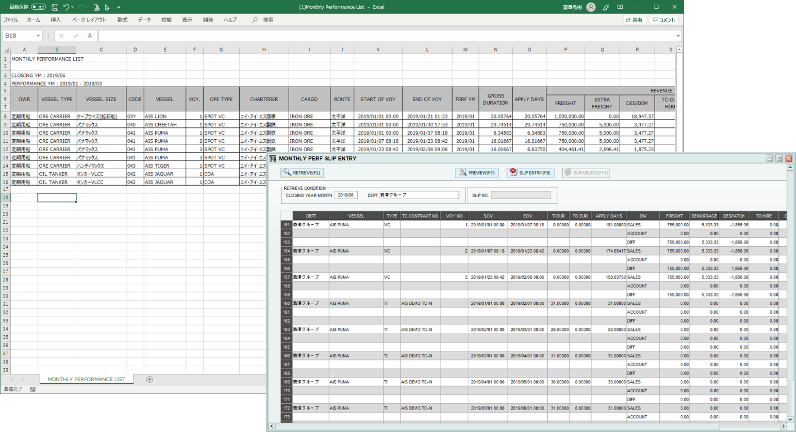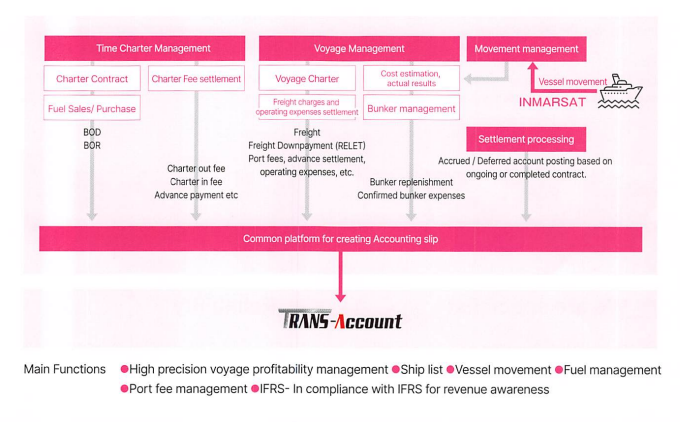
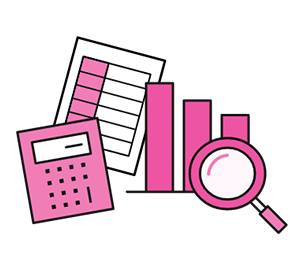
Highly precise voyage profitability estimates and results
Voyage cost estimates can be easily created and various estimates can be compared.It also streamlines cargo contract management, freight and various operating expenses settlement, and fuel management. Furthermore, reports from the ship can be imported and status management is possible. It is a ship operation management system that covers all the functions necessary for independent operation
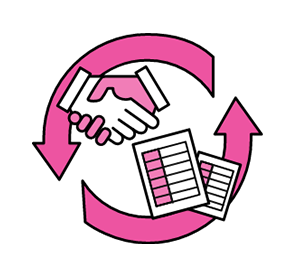
Improving payment efficiency for chartering contracts
It enables the management of charter agreements, fuel sales and purchases, and the settlement of charter hire and advance payments.

Direct link to accounting system for efficient financial settlement
All accounting entries related to operations and chartered vessels are seamlessly integrated into the maritime accounting system “TRANS-Account” through automatic entries. In addition, estimated and deferred closing journal entries are automatically created from voyage profit data.
High-Precision Voyage Profitability Management
The system supports MULTI CARGO and multiple port loading and unloading. By simply linking voyage charter contracts, it automatically generates PORT ROTATION. Based on the vessel’s speed configuration, DISTANCE TABLE, and loading/unloading run information, it calculates ETA/ETD for each port, voyage duration, and fuel consumption automatically. Additionally, it features multiple estimate comparison functions, vessel speed-based C/B (Cost/Benefit) comparisons, and reverse calculation of freight rates from C/B, providing valuable support for profitability analysis. Moreover, as an integrated operation management platform, it connects with other services to achieve even more precise voyage profitability estimates.

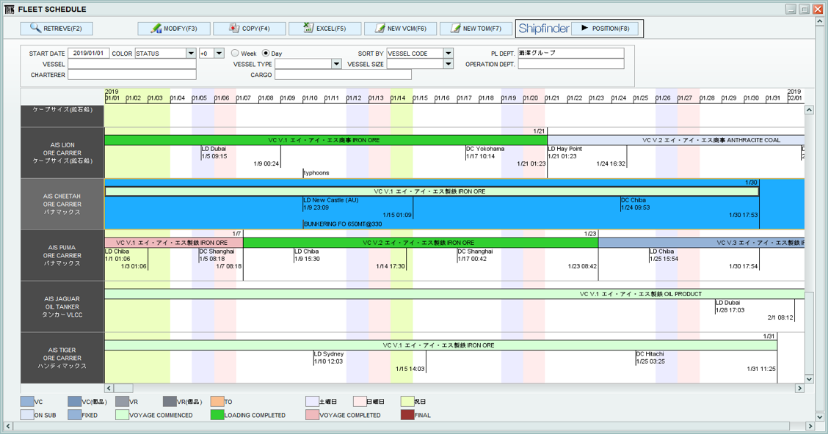
Fleet Allocation Schedule
The fleet’s voyage schedule and performance are visually displayed using bar charts. It displays color-coded information by voyage status, cargo type, and business type (VC / TC-OUT). As voyage performance data is updated, the system automatically adjusts the planned voyage periods, ensuring that the fleet allocation plan is always based on the most current status information.
Additionally, users can directly drill down from the bar chart to the voyage profitability screen to check detailed profitability information, adjust contract terms such as LAY / CAN and REDELI for planned voyages, and make necessary adjustments. The system also supports exporting the display data to Excel for use in fleet allocation meetings.
Ship movement management
Noon Reports, Arrival/Departure Reports, and other status reports can be created on the vessel and sent via email. These reports are then reflected in the voyage profitability statements. Report registration on the vessel is done using a web browser, allowing offline input with the option to use online features.
The types and fields of reports can be freely configured. Additionally, beyond screen display, the data can be exported to Excel for use in fleet allocation meetings
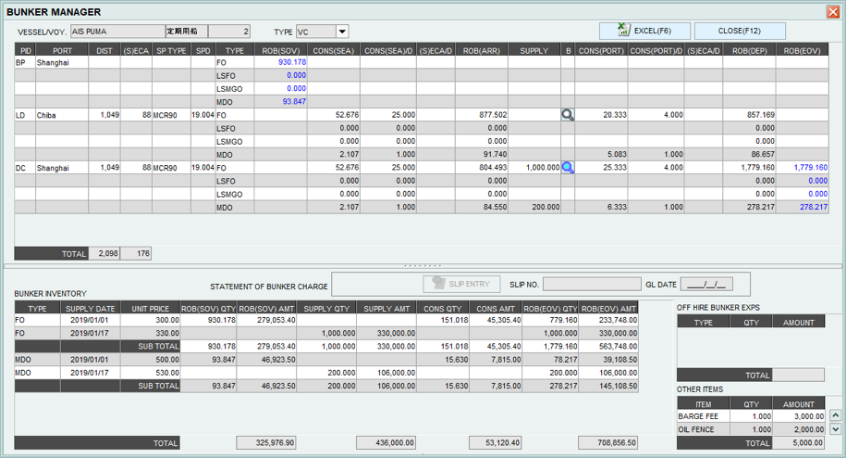
Fuel Management
For each engine output, such as FULL or ECO, fuel consumption for various types of fuel can be set, allowing for simulations based on economic efficiency and punctuality. Within Emission Control Areas (ECA), the system automatically switches to LS fuel and calculates consumption. Fuel inventory calculations are automatically carried over from the previous voyage and calculated using the FIFO (First In, First Out) method. Estimated fuel costs for the period-end and final fuel costs are automatically calculated and integrated with the accounting system.
1. Fuel Purchase
2. Period-End Fuel Inventory
3. Estimated Period-End Fuel Cost Accrual
4. Inventory Management Using First-In, First-Out (FIFO)
5. Fuel Consumption Simulation
6. Fuel Cost Finalization Process
Port Fee Management
It is possible to reflect estimates and actuals from agents in the voyage profitability statement. Additionally, historical port cost data can be reused for estimating voyage profitability. Moreover, port advance payments and settlement results are integrated with the accounting system.
1. Port Cost Advance Payment
2. Port Cost Estimates and Settlements
3. Port Cost Advances Management
4. FDA Excel Import
5. DA-Desk Integration
6. Agency Receivables Management
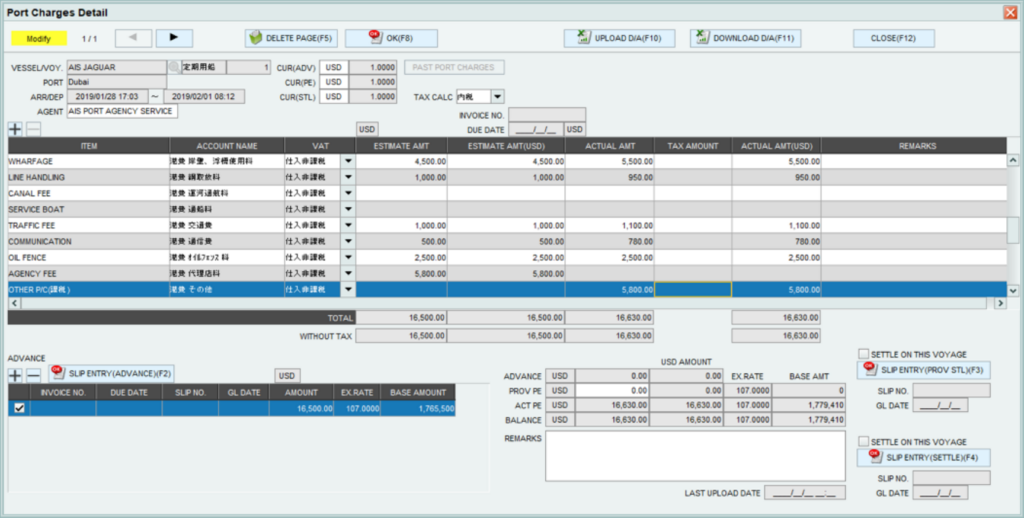

Charter Hire Management
The system automatically generates a settlement schedule based on the terms of registered time charter contracts. During charter hire settlements, it is possible to create HIRE STATEMENTS based on this schedule.
Additionally, the HIRE STATEMENT can incorporate information from the charter contract, such as BOD/BOR, OFF HIRE data entered in the voyage profitability statement, and OWNER’S ACCOUNT information generated during port cost settlements. The created HIRE STATEMENT is then integrated with the accounting system.
Revenue Recognition Based on Progress Method in Compliance with IFRS
Voyages and charter hire spanning multiple accounting periods are automatically prorated to calculate the income and expenses for the current period. Additionally, estimated period-end accruals, deferral entries, and reversal entries are automatically generated and sent to the accounting system, significantly reducing the accounting department’s end-of-period processing workload.
Budgets can also be managed by creating fleet allocation plans for the budget year, which are similarly prorated, allowing for comparison with actual performance.
